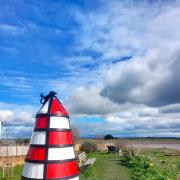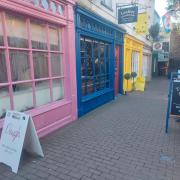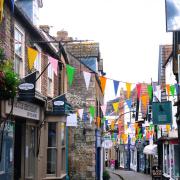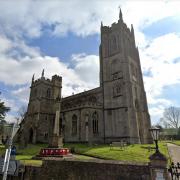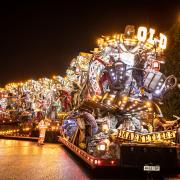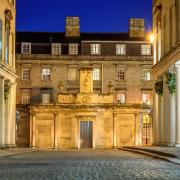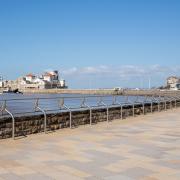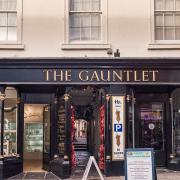WORDS: Clare Kingsbury-Bell

The most well-known legends of Glastonbury revolve around the romantic figures of Joseph of Arimathea and King Arthur.
The town has been identified with the mysterious Isle of Avalon since the 12th century. The Arthur legend is one of Britain’s most famous legends, with more than 100 sites across the country claiming links with him and his knights.
Even if Glastonbury never saw Joseph of Arimathea or King Arthur, the two are inseparable and the town has been shaped by the mysteries that surround it.
King Arthur
The association of Arthur and Glastonbury goes back at least to the early Middle Ages. In 1190 the monks of Glastonbury Abbey announced they had found the grave of Arthur and Guinivere, his queen, to the south of the Lady Chapel.
According to the monks, an excavation found a stone inscribed ‘Here lies Arthur, king’, claiming Glastonbury to be Avalon.
Below the stone they found the bones of a large man, and the smaller skeleton of a woman.
The site became a draw for pilgrims and historians.
The nearby hill fort at South Cadbury has also been identified as the location for Camelot and excavations of the site suggest it was in use during the early 6th century, which is the likeliest era for the real Arthur to have lived.
Joseph of Arimathea
Joseph was the Biblical figure who took Jesus’ body after the crucifixion.
According to some legends he was actually Jesus’ uncle, and had visited Britain years before with Jesus when he was a child, in the pursuit of his interests in the tin trade.
William Blake mentioned the legend in a poem that became the popular hymn Jerusalem - ‘And did those feet in ancient time...’.
It appears that there actually was a strong Jewish presence in the west of England at that time, and many of the tin miners may have been Jewish settlers.
When Jesus died, Joseph fled Palestine and it is said he came to Britain and brought with him the Holy Grail, the cup used by Jesus at the Last Supper. Some versions of the legend have it that the Grail had been used to catch two drops of blood from Jesus’ side when he was on the cross.
The legend that Joseph brought the Holy Grail to Britain was most likely introducted by the French poet Robert de Boron in his 13th century grail story.
The tale says that it was to be guarded in Britain until the rise of King Arthur at Avalon, which is identified with Glastonbury.
Robert de Boron also wrote Merlin, about King Arthur’s early life and rise to glory and his work was reworked later as The Lancelot-Grail, which expands the story to include the quests of the Grail knights and the romance of Lancelot and Guinevere.
In these works, Joseph’s son, Josephus, took over his role as the Grail keeper.
Glastonbury Thorn
Joseph is said to have arrived in Glastonbury by boat over the flooded Somerset Levels. On arriving, he put his staff into the earth and it rooted and flowered miraculously into the Glastonbury Thorn.
This is said to explain a hybrid hawthorn tree that only grows within a few miles of Glastonbury, and which flowers twice a year, once in spring and again at Christmas time.
A cutting from that first tree was planted in the grounds of the later Glastonbury Abbey, where there is still a thorn tree that blooms every Christmas.
Each year a sprig of thorn was cut from the Glastonbury Thorn and sent to the Queen.
The original Holy Thorn was a centre of pilgrimage in the Middle Ages but was chopped down by puritons during the English Civil War.
A replacement thorn was planted in 1951 on Wearyall hill to mark the Festival of Britain; but the thorn had to be replanted the following year as the first attempt did not take.
The Wearyall Hill Holy Thorn was mysteriously vandalised in 2010 when all its branches were chopped off. The tree showed signs of life for a while, but a new sapling, grown from the severed branches, was planted at the site in 2013.
Glastonbury Tor
The Tor is an enigmatic conical hill that rises above the town and has been linked with the Isle of Avalon, where King Arthur was buried.
Two thousand years ago, the sea washed right to the foot of the Tor, nearly encircling the cluster of hills, so it would have appeared as an island.
Avalon was also called the isle of glass, which does suggest similarities to the name Glastonbury and it would have looked as an island on glass when surrounded by water.
Ancient myth describes Avalon as the meeting place of the dead. The place where the sea met the land is said to be the point where they passed to another level of existence, and the Tor was the home of Gwyn ap Nudd, the Lord of the Underworld in Welsh tradition, and a place where the fairy folk lived.
Some legends also suggest that Joseph buried the Holy Grail at the foot of Glastonbury Tor, whereupon a spring of blood gushed from the ground.
There is a well at the base of the Tor called Chalice Well, and the water from it does have a reddish tinge to it, from the iron content of the water.
Around the sides of the Tor is a strange system of terracing. Although weathered and eroded it is still well-defined and has been interpreted by many as a maze following an ancient magical pattern. If this is true, it is likely to have been formed by hand 4-5,000 years ago at a similar time to Stonehenge.
Glastonbury zodiac
In 1934 artist Katherine Maltwood suggested there is a ground plan of each of the signs of the Zodiac said to spread out from the Tor in the defining lines of roadways, rivers and man-made features. She used a medieval manuscript called The High History of the Holy Grail as a key to finding the landscape giants. She thought that their existence was encoded within the work as the various creatures mentioned within it and that it was created by Sumerians about 2700 BC.
The idea of a prehistoric landscape zodiac fell into disrepute when two independent studies examined the Glastonbury Zodiac, one by Ian Burrow in 1975 and the other by Tom Williamson and Liz Bellamy in 1983.
These both used standard methods of landscape historical research. Both studies concluded that the evidence contradicted the idea of an ancient zodiac.
Modern legends
The town is also famous for the many modern legends who have performed at the nearby Glastonbury Festival.
For 2015 it has been announced that soul icon Lionel Richie will take to the stage.
In 1970 the tickets sold for just £1 and The Kinks were the headline act. There were only 1,500 in attendance.
By the mid-1980s tickets had gone up to £17 and acts including The Cure and Madness played to crowds of 40,000.
More than 80,000 people listened to The Cure, Oasis and P J Harvey in 1995 when tickets were £65.
By the millenium tickets had gone up to £87 for the 100,000 people and the festival saw performances from Travis, The Chemical Brothers, and David Bowie.






